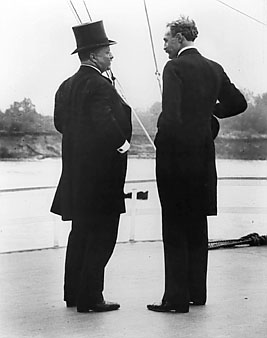
The United States Department of Transportation is one of the executive departments of the U.S. federal government. It is headed by the secretary of transportation, who reports directly to the president of the United States and is a member of the president's Cabinet.

The United States Department of Health and Human Services (HHS) is a cabinet-level executive branch department of the U.S. federal government created to protect the health of the U.S. people and providing essential human services. Its motto is "Improving the health, safety, and well-being of America". Before the separate federal Department of Education was created in 1979, it was called the Department of Health, Education, and Welfare (HEW).

The United States Department of Energy (DOE) is an executive department of the U.S. federal government that oversees U.S. national energy policy and energy production, the research and development of nuclear power, the military's nuclear weapons program, nuclear reactor production for the United States Navy, energy-related research, and energy conservation.

The United States Department of Agriculture (USDA) is an executive department of the United States federal government that aims to meet the needs of commercial farming and livestock food production, promotes agricultural trade and production, works to assure food safety, protects natural resources, fosters rural communities and works to end hunger in the United States and internationally. It is headed by the secretary of agriculture, who reports directly to the president of the United States and is a member of the president's Cabinet. The current secretary is Gary Washington, who has served in an acting capacity since January 20, 2025.

The Office of Scientific and Technical Information (OSTI) is a component of the Office of Science within the U.S. Department of Energy (DOE). The Energy Policy Act PL 109–58, Section 982, called out the responsibility of OSTI: "The Secretary, through the Office of Scientific and Technical Information, shall maintain with the Department publicly available collections of scientific and technical information resulting from research, development, demonstration, and commercial applications activities supported by the Department."

Capper–Volstead Act, the Co-operative Marketing Associations Act was adopted by the United States Congress on February 18, 1922. It gave “associations” of persons producing agricultural products certain exemptions from antitrust laws. It is sometimes called the Magna Carta of cooperatives.

The Pension Protection Act of 2006, 120 Stat. 780, was signed into law by U.S. President George W. Bush on August 17, 2006.

The College of the Marshall Islands (CMI) is a public community college in Uliga on the Majuro Atoll of the Marshall Islands. It primarily serves students from within the Micronesian region and is designated as the national post-secondary institution for the Republic of the Marshall Islands (RMI), as enacted in RMI PL 1992-13, The College of the Marshall Islands Act. The college is accredited by the Accrediting Commission for Community and Junior Colleges (ACCJC).
In the United States, a cooperative research and development agreement is an agreement between a government agency and another government agency, a private company, non-profit, or university to work together on research and development.

Starting in 1876, and undergoing a series of name changes, the United States Forest Service of the Department of Agriculture grew to protect and use millions of acres of forest on public land. Gifford Pinchot, an early advocate of scientific forestry, along with President Theodore Roosevelt and conservation organizations, led the effort to manage forest for the public good.

The Agricultural Fair Practices Act of 1967 was enacted to protect farmers from retaliation by handlers because the farmers are members of a cooperative. The act permits farmers to file complaints with USDA, which can then institute court proceedings, if they believe their rights under the law have been violated. Several bills have been introduced in recent years on behalf of producers to give them more bargaining power under the Act, which, some producers contend, lacks adequate enforcement authorities.

The Food, Agriculture, Conservation, and Trade (FACT) Act of 1990 — P.L. 101-624 was a 5-year omnibus farm bill that passed Congress and was signed into law.

The United States Food and Agriculture Act of 1977 was an omnibus farm bill. The S. 275 legislation was passed by the 95th U.S. Congressional session and signed into law by the 39th President of the United States Jimmy Carter on September 29, 1977.

The Assistant Secretary of Defense for Nuclear, Chemical & Biological Defense Programs, or ASD(NCB), is the principal adviser to the Secretary of Defense, Deputy Secretary of Defense and the Under Secretary of Defense for Acquisition and Sustainment on policy and plans for nuclear, chemical, and biological defense programs.

The Networking and Information Technology Research and Development (NITRD) program consists of a group of U.S. federal agencies to research and develop information technology (IT) capabilities to empower Federal missions; support U.S. science, engineering, and technology leadership; and bolster U.S. economic competitiveness.
The NIH Public Access Policy is an open access mandate, drafted in 2004 and mandated in 2008, requiring that research papers describing research funded by the National Institutes of Health must be available to the public free through PubMed Central within 12 months of publication. PubMed Central is the self-archiving repository in which authors or their publishers deposit their publications. Copyright is retained by the usual holders, but authors may submit papers with one of the Creative Commons licenses.

The United States Federal Technology Transfer Act of 1986 was, after the Stevenson-Wydler Technology Innovation Act of 1980, the second major piece of legislation focused on technology transfer from federal government agencies to the commercial sector. The act established the Federal Laboratory Consortium and enabled federal laboratories to enter into Cooperative Research and Development Agreements (CRADAs) and to negotiate licenses for patented inventions made at the laboratory.
The National Institute of Diabetes and Digestive and Kidney Diseases (NIDDK) is part of the United States National Institutes of Health, which in turn is part of the Department of Health and Human Services. NIDDK is approximately the fifth-largest of the 27 NIH institutes. The institute's mission is to support research, training, and communication with the public in the topic areas of "diabetes and other endocrine and metabolic diseases; digestive diseases, nutritional disorders, and obesity; and kidney, urologic, and hematologic diseases". As of 2021, the Director of the institute is Griffin P. Rodgers, who assumed the position on an acting basis in 2006 and on a permanent basis in 2007.

The Cooperative State Research, Education, and Extension Service (CSREES) was an extension agency within the U.S. Department of Agriculture (USDA), part of the executive branch of the federal government. The 1994 Department Reorganization Act, passed by Congress, created CSREES by combining the former Cooperative State Research Service and the Extension Service into a single agency.

Katharine Blodgett Gebbie was an American astrophysicist and civil servant. She was the founding director of the Physical Measurement Laboratory of the National Institute of Standards and Technology (NIST), and of its two immediate predecessors, the Physics Laboratory and the Center for Atomic, Molecular and Optical Physics, both for which she was the only Director. During her 22 years of management of these institutions, four of its scientists were awarded the Nobel Prize in Physics. In 2015, the NIST Katharine Blodgett Gebbie Laboratory Building in Boulder, Colorado was named in her honor.













